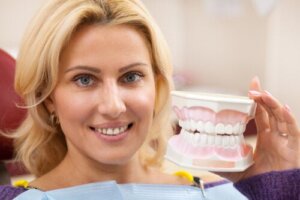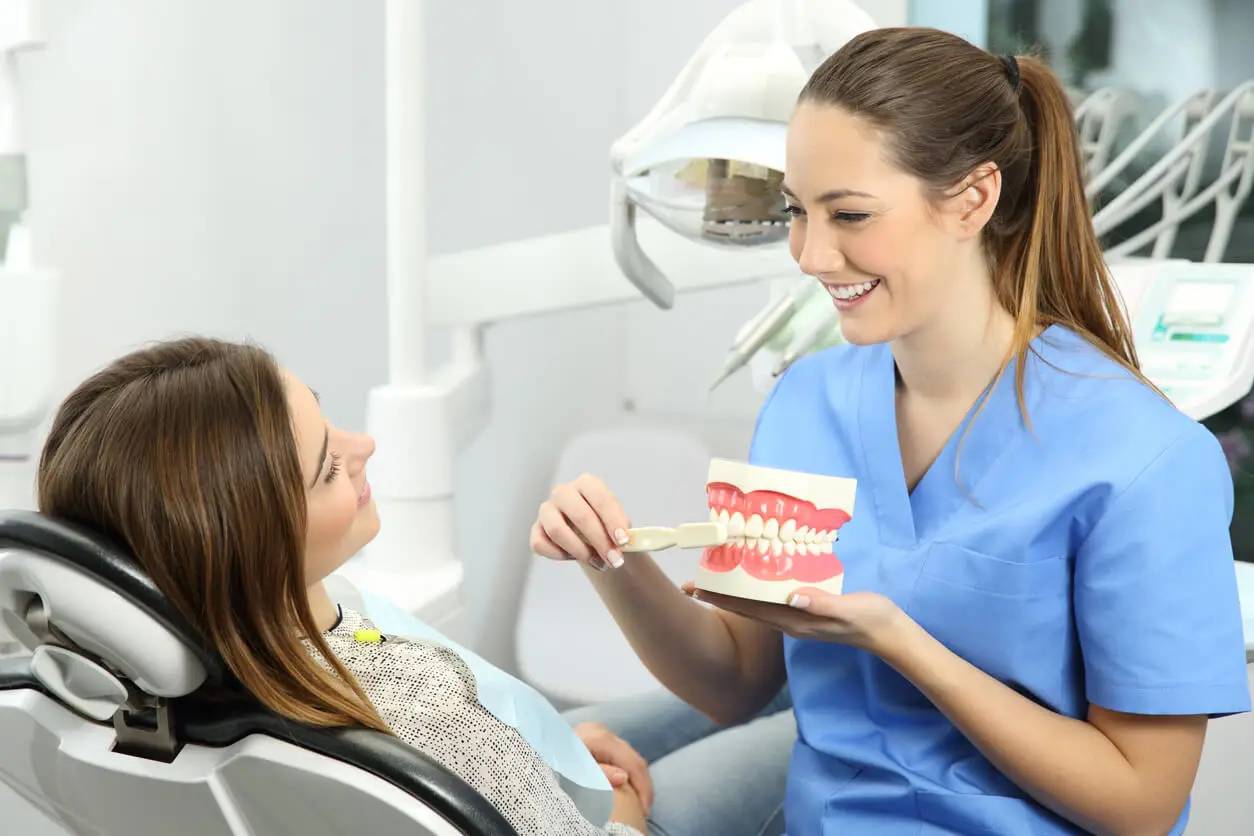All About Gums: What They Do and How to Look After Them


Written and verified by the dentist Vanesa Evangelina Buffa
Gums have a very important protective function in the mouth. They cover our teeth, protecting them from external damage. They also influence the appearance of the smile and oral health in general. That’s why learning more about this part of our mouth and looking after them is extremely important.
However, it’s also important to keep in mind that the gums are composed of several parts and each of them has a different function. Below, we’ll describe their main characteristics and share 7 tips that will help you keep this tissue healthy.
What are gums?
Gums are the mucous membranes of the mouth that surround the teeth. They’re made up of connective tissue covered by epithelium. They’re also known as “gingival tissue”. They’re part of the periodontium, a set of structures responsible for supporting and fixing the teeth within their bony alveolus.
Specifically, this tissue holds each tooth on what is called amelocementary line, which is basically the contour of the gums. In this way, they form a seal that protects the dental root, the bone, and the other supporting structures. For this reason, their care and maintenance are of utmost importance.
If the gums become diseased, they don’t only cause discomfort to the patient. They can also lead to tooth loss and bone-deep conditions
The gingival tissue is made up of dense connective tissue containing fibers and cells. Externally, it’s lined by a keratinized squamous epithelium which, although continuous, is called by different names depending on its location:
- Gingival epithelium in the external visible portion.
- Sulcular epithelium in the internal portion, which forms the free gingival sulcus.
- Insertion or junctional, which is the innermost area of the sulcus, where it joins the enamel of the dental crown.
The normal appearance of a healthy gingiva is pale pink and with a dotted texture, resembling the skin of an orange somewhat. Its defined contours are other characteristics that denote health.
When it changes color, loses its dotted appearance, swells, bothers, or bleeds, it’s because something is wrong. These signs indicate that the gum is irritated by the presence of bacterial plaque or other agents.

Types of gums
Although gingival tissue is a single mucosa responsible for protecting the teeth, it can be divided into different types according to their location. Each of these parts has specific characteristics. We’ll tell you about them below.
Attached gingiva
The attached gingiva is the area of gingival tissue that covers the root portion of the teeth. It’s situated on the periosteum of the alveolar bone that contains the tooth roots. It extends from the marginal gingiva upwards. It reaches the mucogingival junction, where it joins to the alveolar mucosa.
It’s the most visible part of the gingiva, as it’s the one we notice when speaking and smiling. It’s characterized by being elastic, but firm. It has the pale pink coloration that we have already mentioned. Its width depends on the area of the mouth where it’s located. It’s wider in the area of the incisors and narrower at the height of the molars.
Find out more: Natural Remedies for Bleeding Gums
Free gingival margin
The free gingival margin is the portion of tissue that surrounds the neck of the tooth. This area meets the tooth element and forms the gingival sulcus. It ranges in size from 0.5 to 2 mm in width. It extends from the free gingival ridge to the attached gingiva. Its appearance is slightly more translucent than the latter.
As it’s the portion of tissue closest to, and in contact with, the dental crown, it’s where bacterial plaque accumulates. Therefore, its hygiene and care is essential to avoid diseases. This is the area where gum recontouring treatments and grafts are usually performed.
Interdental papilla
This part of the gums is the one between the teeth. It’s located below where the teeth make contact, in what we call the “interproximal area”.
It’s pyramidal in shape at the back of the mouth, but between the molars there are two more flattened papillae – one internal and one external – which are connected by a slight depression. Their width and depth depend on how much tooth surface makes contact with it.
In addition, this portion is characterized by a non-keratinized epithelium. By covering the empty space between the teeth, it fulfills an aesthetic function. It also prevents food debris from being retained in this area.
Alveolar mucosa
This is the tissue with which the attached gingiva joins the mucosa of the lips and cheeks. It’s a dark red area much more lax, elastic and mobile.
It isn’t visible when the mouth is closed and can only be seen if we move our lips apart. It’s much more sensitive to heat and cold. Sores, canker sores, and abscesses often occur here.
What is the role of the gums in the mouth?
We have already told you that the main role of the gums is to cover and protect the teeth and jaws. Below, we’ll go into more detail about its other roles:
- They protect the teeth from the action of germs. The gingiva acts as a barrier that prevents the bone and the root of the teeth from coming into contact with the outside. In this way, it prevents the passage of foreign substances, bacteria, and other microorganisms to the deeper areas of the periodontium.
- They’re involved in the fixation of the teeth to the jaws. They’re part of the tissues that hold the teeth in place. This prevents the teeth from moving and shifting, which is essential for them to fulfill their functions properly.
- They absorb the pressure generated during chewing. Masticatory movements cause forces that are cushioned by the gums. Otherwise, this pressure would fall directly on the bones, causing long-term damage.
- They improve the aesthetics and appearance of our smile. Healthy gums subtly contour the crown of each tooth, giving a harmonious appearance to the dentition.
- They promote oral and general health. Healthy gums prevent the appearance of complications and pathologies in the mouth. In addition, they reduce the risk of suffering or worsening some systemic ailments associated with their deterioration.
What happens when the gums don’t fulfill their function?
When the gums swell, bleed or become diseased they can’t fulfill the functions we mentioned. Gingivitis and periodontal disease are the most frequent disorders that affect this tissue.
Gingivitis is the inflammation of the gums, which become red, swollen, and bleed easily. In general, it’s caused by inadequate oral hygiene, which leads to the accumulation of bacterial plaque and tartar. It’s also associated with the following factors:
- Age
- Hormones
- Stress
- Genetics
- Smoking
- Medications
- Inadequate nutrition
If gingivitis isn’t treated in time, it evolves into what we know as “pyorrhea” or “periodontal disease”. This condition is much more severe, since inflammation and infection occur in the deep areas of the periodontium.
The alveolar bone and supporting tissues are destroyed and the teeth lose their attachment. It’s common for teeth to move and, in the most severe cases, to become dislodged. In addition, this disorder is linked to other body conditions.
Periodontitis can favor the appearance or aggravate systemic pathologies such as diabetes, cardiovascular or neurological pathologies, among others. In the case of pregnant women, it’s associated with complications such as premature births, low birth weight babies, or preeclampsia.
Treating these gum disorders in time will prevent complications and allow the tissue to continue to fulfill its function. As we’ll show you, dental hygiene at home and regular visits to the dentist will help you take care of this tissue.
Find out more: 14 Reasons for Bleeding Gums
Signs to watch out for
There are some signs in your mouth that you should pay attention to, as they may be telling you that something isn’t quite right with your gums. These are the most common manifestations of gum problems:
- Red, swollen, inflamed and sensitive gums
- Bleeding gums when brushing teeth or eating
- Receding gums and exposed tooth roots
- Pus and a bad taste in the mouth
- Movement or separation of the teeth
- Bad breath
7 tips to take care of your gums and keep them doing their job
Taking care of your gums allows this tissue to continue to perform all the functions we’ve mentioned. You’ll see that it isn’t so difficult. If you put these tips into practice, you can keep your gum tissue healthy and problem-free.
1. Brush your teeth and gums
Brushing your teeth is one of the easiest – and most important – ways to take care of your gum tissue. It allows you to remove germs and food debris that form plaque and tartar.
Brushing should be carried out at least 2 or 3 times a day and should last about 2 minutes. Cleaning shouldn’t only include the teeth; the bristles of the brush should also reach the free marginal gum area.
For effective cleaning, the brush should be placed at a 45-degree angle at the joining of the gum and the teeth. Backward and forward, as well as circular and sweeping movements should be combined from the gingival tissue towards the teeth.
Be careful not to overdo the pressure during brushing, as very sharp or intense movements could injure the gums. You should also make sure that you reach all sides of every tooth in your mouth. In other words, you should clean the outer surfaces, the inner surfaces, and the chewing surfaces.
Of course, the tongue shouldn’t be overlooked as bacteria and food debris also accumulate there. In addition, cleaning it allows you to enjoy fresh breath. The toothbrush should have soft bristles and be in good condition. It’s advisable to change it every 3 months or when you notice that the filaments are worn or open.
2. Clean the area between the teeth
Ensuring that the area between the teeth is cleaned is another way to maintain healthy gums. The place where teeth come into contact with each other is often where plaque accumulates. The bristles of the toothbrush can’t reach this area.
To clean the interdental space, floss should be used every day. The floss should pass between teeth, reaching below the gum line, cleaning each of the proximal walls of each tooth.
In addition, to better sanitize this hard-to-reach area you can use other complements, such as irrigators and interdental brushes.
3. Use the right toothpaste
Choosing the right toothpaste is crucial for a healthy mouth, and you should look for a product that contains fluoride. But if you’re unsure which toothpaste is best, consult your trusted dentist.
Some people are more prone to tartar formation and have more sensitive gums. Your dentist will advise you on the most suitable toothpaste for your own specific needs.
4. Complement your hygiene with mouthwashes
The use of mouthwashes to complement oral hygiene is very beneficial. Mouthwashes are able to access all areas of the mouth, even those where brushing and flossing can’t reach. They also make it easier to clean the attached gingiva and alveolar mucosa.
These areas – which are covered by the lips or cheeks – are difficult to clean in any other way. The dentist will provide guidance on the most suitable product, as there are several formulas on the market.
5. Watch your diet
A proper diet boosts the health of our whole body, as well as helping the gums to fulfill their function. Therefore, it’s advisable to give priority to foods of natural origin, abundant in vitamins and minerals.
Vitamins C, B, and K strengthen the gums, so it’s important to include broccoli, citrus fruits, and kiwis in your diet. In addition, it’s a good idea to reduce the consumption of ultra-processed products and products with a high content of simple sugars, which favor the proliferation of bacteria.
Avoid carbonated beverages, sweets and pastries, and prioritize the intake of fresh products.
6. Visit the dentist regularly
Visiting the dentist every six months helps to keep your gums and the rest of your mouth in optimal condition. The professional will advise you on the best ways to take care of your teeth and mouth.
In addition, if there’s a problem, a timely diagnosis can solve it immediately. In this way, you’ll avoid discomfort, complications, and the need for more complex treatment in the future.
Preventive health care (prophylaxis) every six months or once a year is an intervention with significant benefits for the health of the gingival tissue. This professional cleaning will eliminate tartar, bacterial plaque, and stains that domestic brushing fails to remove.

7. Be especially careful if you wear dentures or orthodontics
Having dentures, implants, or wearing braces increases the risk of gum disease. It’s essential to pay special attention to looking after gingival tissue in these cases.
Brushing the prosthesis, the area between implants, and removing bacterial plaque that accumulates on the braces (especially the wires) will prevent damage to this tissue. Cleaning is recommended after each meal, as these devices retain residues that can irritate the gingival tissue.
Healthy gums will do their job well!
Our gums have the important job of keeping our teeth fixed and protected. But they also play an important role in our smile.
With today’s advice, you’ll be able to maintain every part of your gums healthy and working well. In addition, you’ll prevent serious pathologies such as gingivitis and periodontitis, which could mean you’ll lose some teeth and could also have consequences for your overall health.
All cited sources were thoroughly reviewed by our team to ensure their quality, reliability, currency, and validity. The bibliography of this article was considered reliable and of academic or scientific accuracy.
- ELIZABETH, H. R. P. DEFINICION DE ANATOMIA DENTAL Y LAS ESTRUCTURAS ADYACENTES INTIMAMENTE RELACIONADAS CON LOS DIENTES.
- Obando Sánchez, L. A. (2019). Anatomía del periodonto macroanatomia y microanatomia del periodonto.
- Kumar, S. (2019). Evidence-based update on diagnosis and management of gingivitis and periodontitis. Dental Clinics, 63(1), 69-81.
- Karaben, V. E., Lotero, J. C., & Morales, S. C. (2021). Utilización de Clorhexidina en la prevención de enfermedad gingival de pacientes embarazadas. Revista de la Facultad de Odontología, 1(4), 28-33.
- Vereau, N. C., & Palacios, M. A. (2012). Enfermedad gingival en adolescentes: Diagnóstico y tratamiento. Revista Estomatológica Herediana, 22(3), 167-170.
- Cordero, M. J. A., Rivero-Blanco, T., Leon-Rios, X., Rodriguez-Blanque, R., & Gil-Montoya, J. A. (2018). La Enfermedad Periodontal como factor de riesgo de complicaciones durante el embarazo y parto. Journal of Negative and No Positive Results, 3(11), 906-922.
- Cacciola, D., & Gómez, G. M. (2018). Relación entre periodoncia y ortodoncia: complicaciones gingivales y efectos del tratamiento ortodóncico en el periodonto. Biociencias, 13(2).
- Dávila Pinguil, L. A. (2019). Prevalencia de gingivitis en pacientes con prótesis parcial removible y pacientes con tratamiento ortodóntico (Bachelor’s thesis, Universidad de Guayaquil. Facultad Piloto de Odontología).
- Asquino, N., & Villarnobo, F. (2019). Cepillos interdentales, de la teoría a la práctica. Revisión de literatura e indicaciones clínicas. Odontoestomatología, 21(33), 46-53.
- Fonseca, M. D. L. A. L., Vargas, D. B., & Rodríguez, M. Á. L. (2022). Gingivitis crónica: asociación con sexo, higiene bucal y depresión. Revista científica estudiantil 2 de Diciembre, 5(2), 313.
This text is provided for informational purposes only and does not replace consultation with a professional. If in doubt, consult your specialist.








